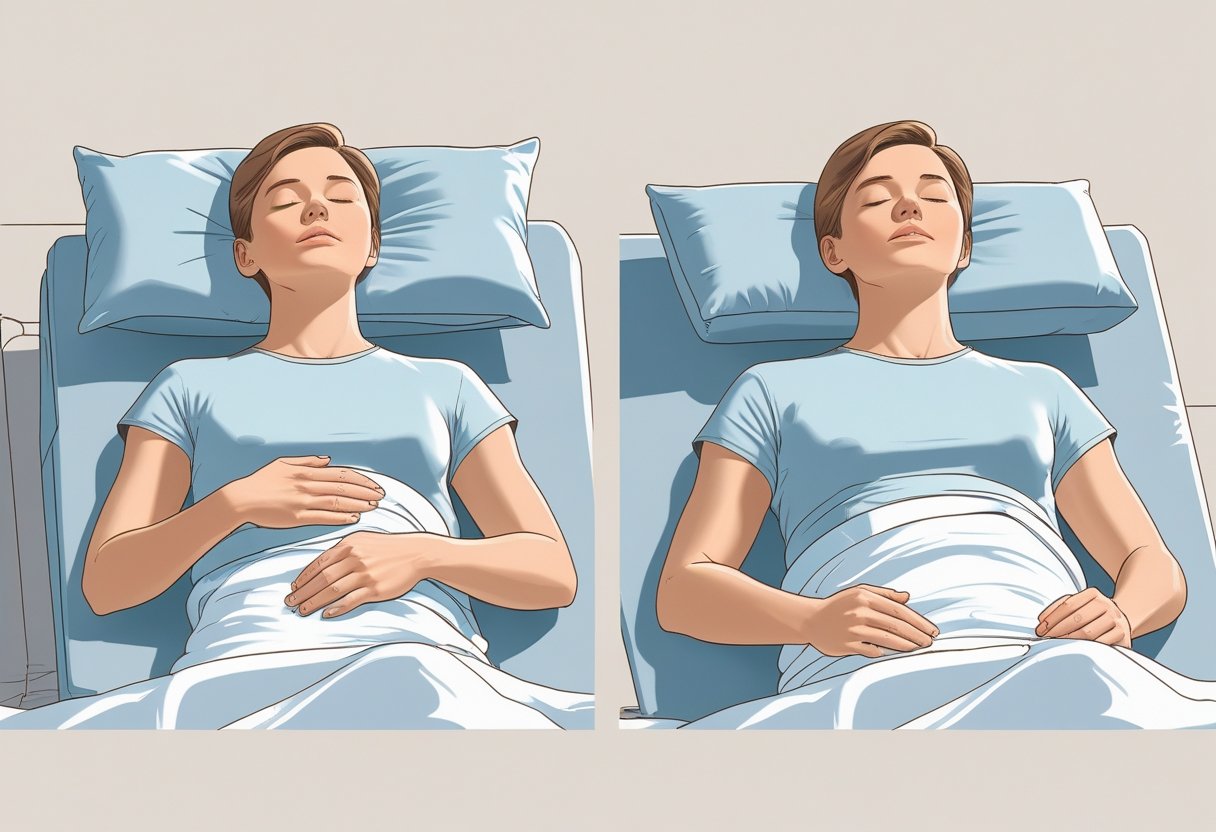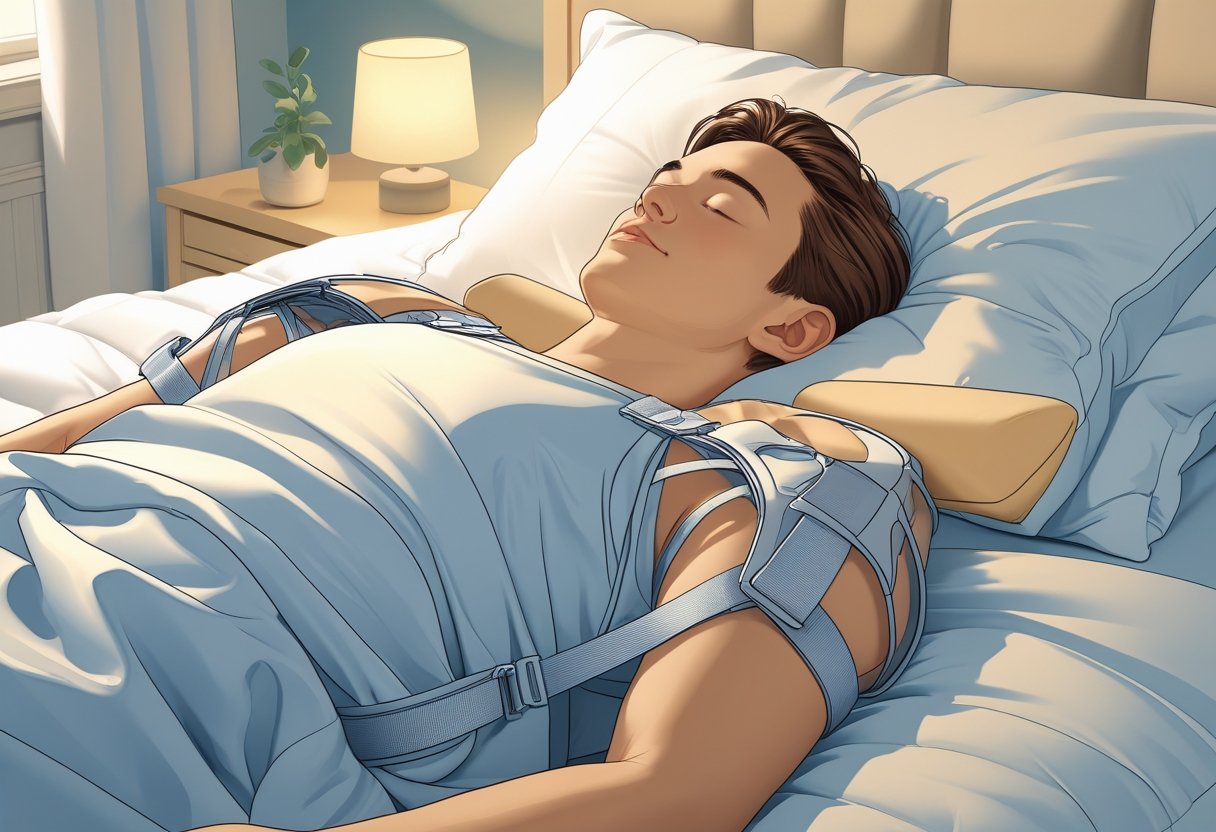Sleeping with shoulder pain can make nights feel long and restless. The best way to handle it is to keep your body in line and take pressure off the sore side. Lying on your back with a pillow tucked under the hurting shoulder usually helps ease the pressure and makes rest more comfortable. You can also try lying on the opposite side if that feels easier.
Adding a pillow between or under your arms helps keep your shoulders steady while you sleep. For stronger pain, resting in a slightly raised position can take pressure off irritated areas. Even small shifts in how you lie down, along with the right pillows, can make a real difference.
The way you sleep has a direct effect on how your shoulder feels. Choosing positions that protect the shoulder not only helps you stay comfortable but also supports faster recovery. Below are some simple tips that can guide you toward a more restful night.
Key Takeaways
- Sleeping in the right position lowers shoulder strain and pain.
- Supportive pillows make it easier to stay comfortable through the night.
- Adjusting how you sleep can improve rest and recovery.
- A mattress that cushions pressure points and keeps your spine aligned works best, especially for side sleepers with shoulder pain.

Understanding Shoulder Pain At Night

Shoulder pain at night makes it hard to rest and can carry over into the next day. The discomfort might come from an injury, swelling, or even how someone sleeps. Knowing the cause and how sleep positions affect the shoulder can make it easier to manage. It also helps to tell the difference between types of pain, since not all shoulder pain is the same.
Common Causes of Shoulder Pain While Sleeping
Nighttime shoulder pain often comes from injuries like rotator cuff tears, bursitis, or frozen shoulder. These problems irritate or damage the muscles and tendons around the joint. Overusing the shoulder during the day or having poor posture can also trigger pain once it’s time to rest.
Sleeping on the stomach is one of the main reasons for discomfort. This position pushes the shoulder into odd angles and puts weight directly on it. Pinched nerves and arthritis are other possible causes. They usually create steady, dull pain that gets worse with certain movements or when lying still. Stiffness and swelling may also make it tough to get comfortable.
How Sleep Positions Impact Shoulder Pain
The way someone sleeps can either ease pain or make it worse. Lying on the back is usually the most supportive position, especially for an injured shoulder. It keeps pressure off the joint and helps with alignment. A small pillow under each arm can add comfort and reduce strain. Sleeping on the side can still work, but it should be done carefully. It’s best to rest on the opposite side of the painful shoulder. A pillow under the injured arm can keep it lifted and supported. What’s important is that the arm doesn’t stay pressed tightly against the body.
Stomach sleeping tends to cause the most trouble. It twists the shoulder and can make inflammation or injuries worse. Breaking this habit often leads to less pain and protects the joint from further damage.
Differentiating Types of Shoulder Pain
Not all shoulder pain feels the same, and understanding the type can point to the right care. Sharp pain that feels stabbing could mean a rotator cuff tear, which usually needs medical attention. A dull, ongoing ache often comes from swelling linked to bursitis or frozen shoulder. If pain shows up mostly at night or gets worse with movement, shoulder impingement might be the problem. This happens when tendons are pinched between bones. In some cases, simple changes like adjusting sleep position or using cold or heat packs can bring relief.
Constant pain with swelling or redness may be a sign of infection or a more serious injury. Being able to tell whether pain is new or long-lasting makes it easier to know if medical help is needed or if home care will do.
Best Sleeping Positions For Shoulder Pain
Finding a position that reduces pressure and supports the shoulder is key to better sleep. Adjusting how you place your arms and the angle of your body can help reduce pain, especially for issues like rotator cuff injuries or soreness in the shoulder blade. Using the right pillow keeps joints aligned and stops extra strain overnight.
Back Sleeping Techniques
Sleeping on your back can help ease shoulder pain. Rest the affected arm across your stomach with the elbow bent. Placing a pillow under the arm lifts it slightly and takes pressure off the joint.
A pillow under the knees supports the lower back and keeps the spine in line. This can prevent tension from building in the shoulders or upper back. Avoid letting the arm fall flat at your side, as this can make pain worse. Keeping the arm lifted and close to the body protects muscles and tendons.
Side Sleeping on the Unaffected Shoulder
If you sleep better on your side, lie on the side that doesn’t hurt. Place a pillow in front of your chest and rest your painful arm on it. Another pillow on top can lift the arm more and reduce pressure.
A pillow between the knees helps keep hips and spine aligned, stopping your body from twisting and aggravating the shoulder. Sleeping on the painful side should be avoided, as it usually increases discomfort. Use a firm pillow under your head to keep the neck straight and reduce tension in the shoulder blade.
Reclined and Elevated Positions
Sleeping with the upper body slightly raised can also help. Use an adjustable bed or stack pillows behind your back to stay semi-upright.
This position takes weight off the shoulders, which is useful after surgery or during flare-ups. A small pillow under the affected arm keeps the joint stable and elevated, reducing swelling and limiting movement that causes pain. Elevated positions can also improve circulation, which helps reduce stiffness overnight and supports healing.

Pillow And Mattress Recommendations
Proper pillow and mattress choices reduce shoulder strain and improve alignment during sleep. The right combination supports the neck and upper body, eases pressure on sensitive areas, and encourages recovery.
Choosing The Right Pillow
The right pillow helps shoulder pain. Pillows that contour to the neck and head help keep the spine straight. Cervical pillows with a groove for the neck can reduce strain by keeping the head from tilting awkwardly.
Memory foam and latex pillows shape to the head and neck, spreading pressure evenly. Avoid pillows that are too tall or stiff, as they can twist the shoulder and make pain worse. Side sleepers often do best with a medium-loft pillow, and placing one under the arm or using a wedge pillow can keep the shoulder relaxed.
Pillow Positioning And Support
Where you put your pillow matters. A thin wedge under the sore shoulder can lift it slightly and ease pressure. Side sleepers may find a pillow between the knees helps align the hips and spine, which also relieves shoulder tension. A long body pillow can support the arm and stop it from falling forward.
Back sleepers can use a slim pillow under the arms or a cervical contour pillow. This keeps shoulder muscles relaxed and helps maintain good posture through the night.
Selecting A Supportive Mattress
A mattress that cushions the body while keeping the spine in line can ease shoulder pain. Medium-soft mattresses with memory foam or latex can relieve pressure without letting the body sink too far.
Too firm mattresses do not relieve pressure points and may make pain worse. Too soft mattresses can throw the spine out of alignment and increase strain. Breathable materials that prevent heat buildup are also helpful, since heat can irritate shoulder tissues.
Choose a mattress that moves with your body and supports natural sleep positions. This reduces twisting and awkward positions that can worsen shoulder pain.

Shoulder Braces And Supportive Devices
Using the right shoulder support reduces pain and protects the joint during sleep. Braces come in different styles, each designed for certain injuries or levels of pain. Getting the right fit makes it comfortable without stopping important movement.
When To Use A Shoulder Brace For Sleeping
A shoulder brace can help when pain or injury makes it hard to rest. It supports issues like rotator cuff tears, tendonitis, or bursitis. People recovering from surgery often find it useful to wear one at night. The brace stops movements that could make pain worse while sleeping. But it shouldn’t replace medical care if the injury is serious. These devices work best for mild to moderate pain.
For anyone who wakes up because of shoulder discomfort, a brace can give steady support. It may also reduce swelling by limiting too much motion while still allowing some movement. This balance can make sleep easier without making the shoulder stiff.
Types Of Shoulder Braces
Braces come in several types depending on what you need:
- Compression Sleeves: Give light pressure and warmth, good for mild pain or swelling.
- Rotator Cuff Braces: Stop extreme arm movements and help injuries heal.
- Sling Braces: Keep the arm close to the body, useful after surgery or for strong pain.
- Shoulder Immobilizers: Limit most shoulder movement, usually for serious injuries.
Choosing the best brace depends on your injury and pain level. Adjustable models that fit men and women are common. Materials like neoprene or mesh help air flow and keep skin cool.
Adjusting Braces For Comfort
Proper adjustment matters for support and comfort. The brace should be snug but not tight enough to affect breathing or circulation. Straps and closures should be easy to handle and secure enough to stay put overnight. Measuring your chest or arm before buying helps get the right fit. A poor fit can be uncomfortable or reduce support. Some braces have padding at pressure points to ease stress on joints and bones.
Placing the brace to allow slight movement helps blood flow and prevents stiffness. Some models have pockets for ice packs to reduce pain. Adjusting the fit after a few hours may make it more comfortable through the night.

Relaxation And Preparation Before Bed

Preparing the body before sleep may reduce shoulder pain and improve rest quality. Relaxation techniques, gentle stretching, and heat or cold therapy can ease muscle tightness and lower inflammation to relieve discomfort overnight.
Relaxation Techniques for the Shoulder
Relaxing the shoulder muscles before bed helps release tension that may trigger or worsen pain. Simple methods like deep breathing and progressive muscle relaxation, tightening then slowly releasing the shoulder and arm muscles, can be effective. A good way to begin is by lying on your back with a small pillow under each arm. Let the weight of your arms pull the shoulders away from the ears. This position calms the nervous system, reduces stiffness, and may ease shoulder blade spasms.
Spending 10 to 20 minutes on relaxation gives the muscles a chance to unwind. Avoid screens and bright lighting during this time to support a smoother transition into sleep.
Stretching and Light Exercises
Gentle stretches improve circulation and reduce shoulder stiffness. Movements like shoulder rolls, neck stretches, and pendulum swings, where the arm circles freely, are simple and effective. Each motion should feel comfortable. Forcing a stretch or moving too quickly can worsen the pain. Those dealing with spasms often benefit from stretching before bed, as it helps calm the muscles and reduce tightness.
A 5 to 10-minute routine focusing on the shoulder blades, neck, and upper back can support mobility and prevent strain, setting the stage for better rest.
Applying Heat or Ice
Using heat or ice before bed can target specific sources of shoulder pain. Ice works best for inflammation or swelling. A cold pack applied for 15 to 20 minutes can reduce puffiness and numb the joint area. Heat, on the other hand, relieves chronic discomfort or tightness. A heating pad or warm compress helps loosen the muscles and ease stiffness, which is useful for ongoing shoulder blade spasms.
Avoid falling asleep with a hot or cold pack in place. Always wrap it in a cloth to protect the skin. Alternating heat and cold depending on the issue may bring more relief and help improve sleep comfort.
When To Seek Medical Advice
Shoulder pain that affects sleep can range from mild to serious. It’s important to know when discomfort signals a more severe issue that needs professional care. Not every ache requires a doctor, but certain signs should never be ignored.
Signs of Serious Shoulder Injury
Seek immediate medical attention for sharp, intense pain that starts suddenly. Sudden swelling or bruising around the shoulder often indicates underlying damage. Inability to lift the arm, reduced range of motion, or weakness during movement may point to a torn muscle or ligament.
Severe pain that continues or worsens despite rest or over-the-counter pain relief, or pain accompanied by numbness or tingling down the arm, can also suggest nerve involvement. In these cases, delaying medical care or trying to self-treat may lead to a more serious condition.
Shoulder Pain After Surgery or Trauma
Pain that develops or persists after surgery or a fall should be checked by a medical professional. If pain increases rather than gradually subsiding after surgery, it may signal infection or complications.
Shoulder pain following trauma, such as a fall or accident, may involve fractures, dislocations, or tendon damage that interferes with healing. If pain worsens or new movement loss occurs, prompt evaluation is essential to prevent lasting damage. Follow your doctor’s guidance on sleep positions to reduce strain and protect healing tissue.
Working With Healthcare Professionals
A proper diagnosis and personalized treatment plan from a doctor make a major difference in recovery.
Physical therapists often offer tailored exercises and strategies to help you sleep without aggravating the injury. Doctors may order imaging to detect deeper problems and recommend medication or further treatment when needed. Sharing details about your pain, movement issues, and sleep challenges helps your care team create the most effective plan for recovery.
Early care can lead to better outcomes, and better sleep, without risking further injury.

How Your Mattress Affects Shoulder Pain and Sleep Quality
A mattress is important in managing shoulder pain during sleep. It must strike the right balance between support and pressure relief to keep the spine aligned and take pressure off the shoulders. When a mattress feels too firm, it creates pressure points around the shoulder and causes pain and discomfort. Conversely, a mattress that feels too soft may not provide enough support, which leads to poor posture and increased pain.
Mattresses designed to ease shoulder pain usually use materials that adapt to the body while still providing firm enough support for the spine. Memory foam and hybrid mattresses serve as common choices because they provide this balance. The Puffy Lux Mattress combines multiple foam layers to contour the body while maintaining proper support, making it a popular option for those seeking relief from shoulder discomfort.
The Puffy Lux Mattress features cooling cloud foam to regulate temperature, alongside gel-infused memory foam that relieves pressure. Its breathable cover adds to overall comfort, which benefits side sleepers who require extra cushioning around the shoulders without sacrificing spinal alignment.
Quality matters just as much. A worn-out mattress loses its ability to support and cushion your body the way it should. This can make shoulder pain worse and hurt your overall sleep quality. Experts usually suggest replacing your mattress every 7 to 10 years, or sooner if you notice sagging. Your mattress also affects sleep posture. Side sleepers, who are more likely to deal with shoulder pain, tend to benefit from mattresses that ease pressure without allowing the body to sink too deeply. This helps keep the spine aligned and reduces discomfort.
If a new mattress isn’t in the cards right now, a simple mattress topper can add an extra layer of cushion and relief in the meantime.
- Firmness (medium-soft): Relieves pressure and supports spinal alignment.
- Memory foam: Contours to the body and helps reduce pressure on the shoulders.
- Hybrid: Combines sturdy support with cushioning comfort.
- Old mattress: Can worsen shoulder pain and fail to provide proper support.

Frequently Asked Questions
Proper sleep positioning, supportive gear, and small adjustments can make a big difference in reducing shoulder pain at night. Using pillows and braces correctly, along with avoiding certain sleeping postures, are important in comfort and healing.







